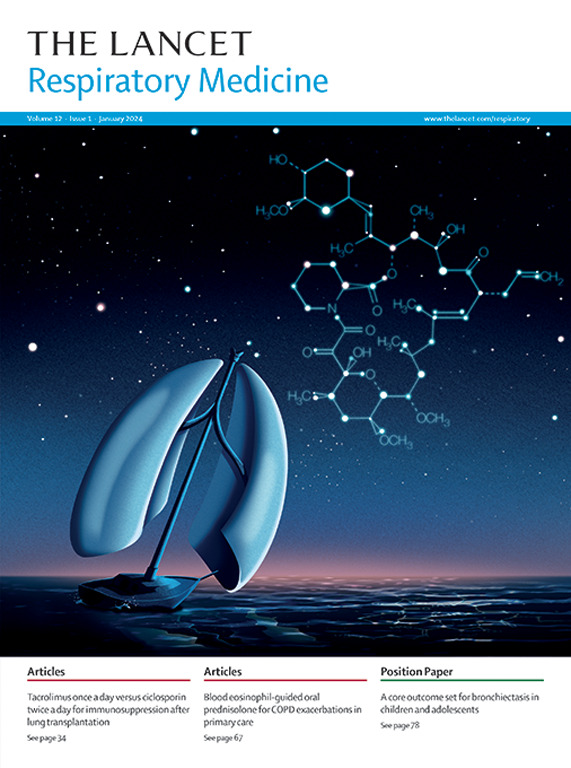评估机械通气患者潮汐量设定公式的通用性:一项观察性、多队列、回顾性研究
IF 32.8
1区 医学
Q1 CRITICAL CARE MEDICINE
引用次数: 0
摘要
背景:在ARMA试验中,低潮气量(VT)的肺保护性机械通气降低了死亡率。在该试验中,VT被调整为预测体重(PBW)作为损伤前肺容量的代表,这种方法现在通常用于机械通气患者设定目标VT。在其他临床情况下,PBW不用于估计肺容量,而是使用肺活量参考方程。我们的目的是比较预测的强迫肺活量(PFVC),使用全球肺倡议2012肺活量参考方程计算,PBW作为损伤前肺容量的代理。方法在这项观察性、多队列、回顾性研究中,我们比较了ARMA PBW与全球肺倡议2012参考方程估计的PFVC两个队列:重症监护医疗信息市场- iv (MIMIC-IV),来自美国马萨诸塞州波士顿单一学术医疗中心的患者队列,以及电子重症监护病房合作研究数据库(eICU-CRD),来自美国208家医院的患者队列。患者包括肺保护通气、低氧血症、身高在150-210 cm范围内的患者。这些数据是从公开可用的、未识别的数据集中收集的。然后,我们研究了在接受肺保护通气的患者中,当VT / PBW为6-8 mL/kg时,正常化VT (VT / PBW或VT / PFVC)与肺体积估算(PBW:PFVC)和死亡率、驱动压力和正常化弹性的比例之间的关系。结果:9152例患者来自MIMIC-IV,其中女性3064例(33.5%),男性6088例(66.5%);黑人645人(7.0%),白人5885人(64.3%),其他种族2622人(28.6%);平均年龄63岁[SD 16]),共纳入12420例eICU-CRD患者(女性4262例[34.3%],男性8158例[65.7%];1023[8.2%]黑人,1093[81.3%]白人,1304[10.5%]其他种族;平均年龄62岁[SD 16])。具有相同PBW的年轻、男性和白人患者的pfvc高于年龄较大、女性和非白人患者。PBW:PFVC比值每增加1 SD, MIMIC-IV患者的死亡几率增加1.43倍(95% CI 1.17 - 1.76), eICU-CRD队列中也观察到类似的结果。解释:与其他患者相比,使用PBW公式调整VT会导致对年龄较大、身材较矮、女性和非白人患者损伤前潮汐肺容量的高估。这种算法偏差可能导致通气患者的死亡率差异。需要进一步的研究来确定机械通气患者的最佳潮气量。资助国家心脏,肺和血液研究所。本文章由计算机程序翻译,如有差异,请以英文原文为准。
Evaluating the generalisability of formulas used to set tidal volumes in mechanically ventilated patients: an observational, multicohort, retrospective study
Background
Lung-protective mechanical ventilation with low tidal volume (VT) decreased mortality in the ARMA trial. VT in that trial was adjusted to predicted bodyweight (PBW) as a proxy for preinjury lung volumes, an approach that is now commonly used to set target VT in patients who are mechanically ventilated. In other clinical contexts, PBW is not used to estimate lung volumes and spirometric reference equations are used instead. We aimed to compare predicted forced vital capacity (PFVC), calculated using the Global Lung Initiative 2012 spirometric reference equations, with PBW as a proxy for preinjury lung volume.Methods
In this observational, multicohort, retrospective study we compared ARMA PBW with PFVC estimated with the Global Lung Initiative 2012 reference equations for two cohorts: Medical Information Mart for Intensive Care-IV (MIMIC-IV), a cohort of patients from a single academic medical centre in Boston, MA, USA, and electronic Intensive Care Unit Collaborative Research Database (eICU-CRD), a cohort of patients from 208 hospitals in the USA. Patients who had lung-protective ventilation, hypoxaemia, and height in the range 150–210 cm were included. The data were collected from publicly available, deidentified datasets. We then studied the association between normalised VT (VT per PBW or VT per PFVC) and the ratio of lung volume estimates (PBW:PFVC) and mortality, driving pressure, and normalised elastance in patients receiving lung-protective ventilation with VT per PBW of 6–8 mL/kg.Findings
9152 patients were included from MIMIC-IV (3064 [33·5%] female and 6088 [66·5%] male; 645 [7·0%] Black, 5885 [64·3%] White, and 2622 [28·6%] other race; mean age 63 years [SD 16]) and 12 420 patients were included from eICU-CRD (4262 [34·3%] female and 8158 [65·7%] male; 1023 [8·2%] Black, 10 093 [81·3%] White, and 1304 [10·5%] other race; mean age 62 years [SD 16]). Patients who were younger, male, and White had greater PFVCs than patients who were older, female, and non-White with the same PBW. A 1 SD increase in PBW:PFVC ratio was associated with 1·43-fold (95% CI 1·17–1·76) higher odds of death in MIMIC-IV and similar results were observed in the eICU-CRD cohort.Interpretation
Adjusting VT using PBW formulas leads to overestimation of preinjury tidal lung volumes in patients who are older, shorter, female, and non-White compared with other patients. This algorithmic bias could contribute to mortality disparities in patients who are ventilated. Further research is required to establish the optimal tidal volumes for patients who are mechanically ventilated.Funding
National Heart, Lung, and Blood Institute.求助全文
通过发布文献求助,成功后即可免费获取论文全文。
去求助
来源期刊

Lancet Respiratory Medicine
RESPIRATORY SYSTEM-RESPIRATORY SYSTEM
CiteScore
87.10
自引率
0.70%
发文量
572
期刊介绍:
The Lancet Respiratory Medicine is a renowned journal specializing in respiratory medicine and critical care. Our publication features original research that aims to advocate for change or shed light on clinical practices in the field. Additionally, we provide informative reviews on various topics related to respiratory medicine and critical care, ensuring a comprehensive coverage of the subject.
The journal covers a wide range of topics including but not limited to asthma, acute respiratory distress syndrome (ARDS), chronic obstructive pulmonary disease (COPD), tobacco control, intensive care medicine, lung cancer, cystic fibrosis, pneumonia, sarcoidosis, sepsis, mesothelioma, sleep medicine, thoracic and reconstructive surgery, tuberculosis, palliative medicine, influenza, pulmonary hypertension, pulmonary vascular disease, and respiratory infections. By encompassing such a broad spectrum of subjects, we strive to address the diverse needs and interests of our readership.
 求助内容:
求助内容: 应助结果提醒方式:
应助结果提醒方式:


